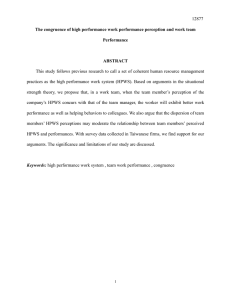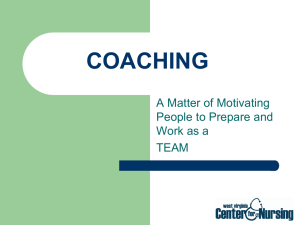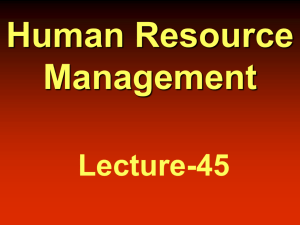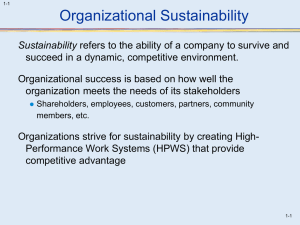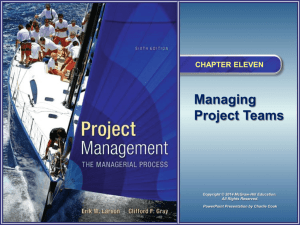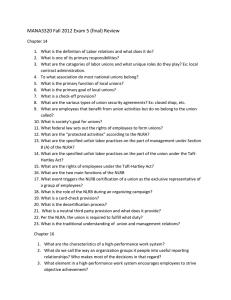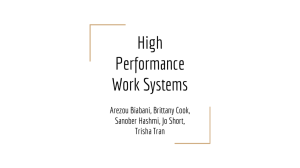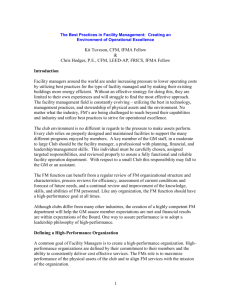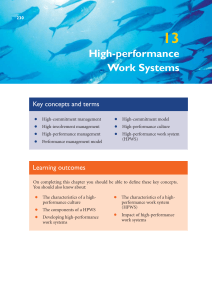High Performance Work Systems
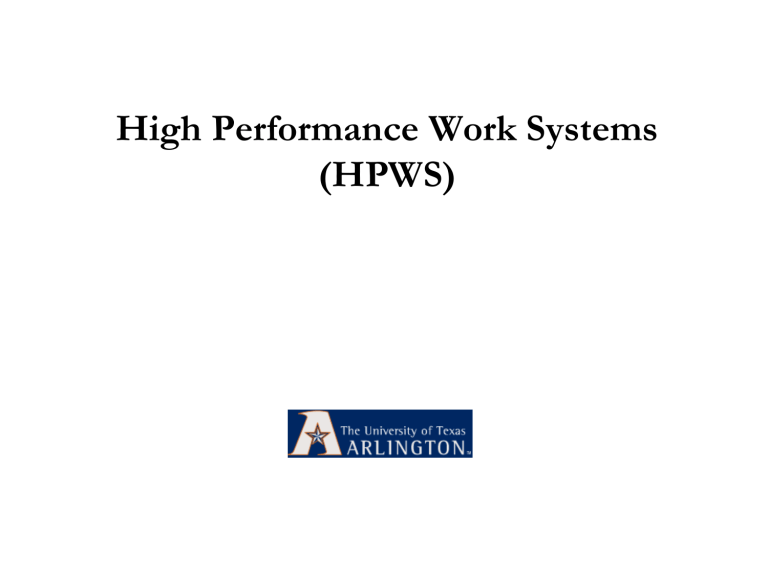
High Performance Work Systems
(HPWS)
HR Alignment
Employee
Relations
Planning and
Job Design
Compensation
Recruiting and
Selection
Performance
Management
Training and
Development
HR Alignment
Employee
Relations
Planning and
Job Design
Compensation
INTERNAL
FIT
Recruiting and
Selection
Performance
Management
Training and
Development
HR Alignment
Employee
Relations
Planning and
Job Design
Compensation
INTERNAL
FIT
Recruiting and
Selection
Performance
Management
Training and
Development
High-Performance Work System
A specific combination of HR practices, work structures, and processes that maximizes employee knowledge, skill, commitment, and flexibility.
Systems composed of many interrelated parts that complement one another to reach the goals of an organization, large or small.
Developing High-Performance Work Systems
Egalitarianism
Shared
Information
Underlying Principles
Knowledge
Development
Performanc e-Reward
Linkage
Egalitarianism
“Decision Power”
Shared
Information
“Information
”
Underlying Principles
Knowledge
Development
“Knowledge”
Performanc e-Reward
Linkage
“Rewards”
Principles of HPWS
Egalitarianism and Engagement
Egalitarian work environments eliminate status and power differences and, in the process, increase collaboration and teamwork.
When this happens, productivity can improve if people who once worked in isolation from (or opposition to) one another begin to work together.
Principles of HPWS (cont’d)
Shared Information
A shift away from the mentality of command and control toward one more focused on employee commitment.
Creating a culture of information sharing where employees are more willing (and able) to work toward the goals for the organization.
Principles of HPWS (cont’d)
Knowledge Development
Employees in high-performance work systems need to learn in “real time,” on the job, using innovative new approaches to solve novel problems
The number of jobs requiring little knowledge and skill is declining while the number of jobs requiring greater knowledge and skill is growing rapidly.
Principles of HPWS (cont’d)
Performance-Reward Linkage
It is important to align employee and organizational goals. When rewards are connected to performance, employees will naturally pursue outcomes that are mutually beneficial to themselves and the organization.
Anatomy of High-Performance Work Systems
Complementary Practices
Training and
Development
Staffing Compensation
Ensuring Fit
Internal fit
The situation in which all the internal elements of the work system complement and reinforce one another.
External fit
The situation in which the work system supports the organization’s goals and strategies.
Assessing Strategic Alignment:
Fitting It All Together
The HR Scorecard
Assessing Internal fit
Do all internal elements of the HR system complement and reinforce one another?
Assessing HR Practices
Do HR practices significantly enable key workforce deliverables such as employment stability and teamwork?
Assessing External Fit
Are workforce deliverables connected with key strategic performance drivers?
Implementing the System
Necessary Actions for a Successful HPWS:
Ensure that change is owned by senior and line managers.
Allocate sufficient resources and support for the change effort.
Ensure early and broad communication.
Ensure that teams are implemented in a systemic context.
Establish methods for measuring the results of change.
Ensure continuity of leadership and champions of the initiative.
Implementing High-Performance Work Systems
Benefits of HPWS
Employee Benefits
Have more involvement in the organization.
Experience growth and satisfaction, and become more valuable as contributors.
Organizational Benefits
High productivity
Quality
Flexibility
Customer satisfaction
Navigating the Transition to
High-Performance Work Systems
Build a Transition
Structure
Implement
High-performance Work
Incorporate the HR Function as a Valuable Partner
Evaluating the Success of the System
Process audit
Determining whether a high-performance work system has been implemented as designed:
Are employees actually working together, or is the term
“team” just a label?
Are employees getting the information they need to make empowered decisions?
Are training programs developing the knowledge and skills employees need?
Are employees being rewarded for good performance and useful suggestions?
Are employees treated fairly so that power differences are minimal?
Evaluating the Success of the System
(cont’d)
To determine if a HPWS program is reaching its goals:
Are desired behaviors being exhibited on the job?
Are quality, productivity, flexibility, and customer service objectives being met?
Are quality-of-life goals being achieved for employees?
Is the organization more competitive than in the past?
Outcomes of High-Performance Work
Systems
Employee Outcomes and Quality of Work Life
More involved in work
More satisfied and find that needs for growth are more fully met
More informed and empowered, feel that they have a fuller role to play in the organization and that their opinions and expertise are valued more
Have a greater commitment that comes from higher skills and greater potential for contribution
Outcomes of High-Performance Work
Systems (cont’d)
Organizational Outcomes and Competitive
Advantages
Higher productivity
Lower costs
Better responsiveness to customers
Greater flexibility
Higher profitability
Employee Involvement
Power
Authority to change job processes?
Self-managed teams
Information
Is business information shared?
Does the job involve performance feedback?
Knowledge
Does the employee have proper training for the job?
Rewards
Are rewards contingent on individual performance?
Employee Involvement
Locating work decisions at the lowest level possible.
Power
Information
Rewards
Knowledge and skills
ROA
ROI
EI in the Fortune 1000
150 Companies
1999 Survey
ROE
Market Return
Market/ Book
Low
EI
Med
EI
9.3
9.7
High
EI
11.2
14.2 15.7
17.1
23.4 20.7
26.6
-.7
2.8
11.9
.7
1.3
1.8
Lawler, Mohrman & Benson, 2000

